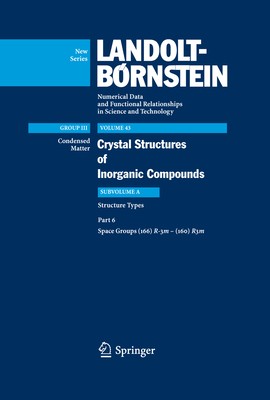
- We will send in 10–14 business days.
- Author: Pierre Villars
- Publisher: Springer
- ISBN-10: 3540447490
- ISBN-13: 9783540447498
- Format: 20.3 x 28.5 x 4.8 cm, kieti viršeliai
- Language: English
- SAVE -10% with code: EXTRA
Reviews
Description
In the 1970s Landolt-Börnstein published a series of volumes containing crystallographic data for organic (III/5 Structure Data of Organic Crystals), intermetallic (III/6 Structure Data of Elements and Intermetallic phases) and inorganic compounds (III/7 Crystal Structure Data of Inorganic Compounds). During the 30 years that have passed, the experimental methods leading to a complete structure determination have considerably improved and the large number of crystal structures known today justifies the publication of a new compilation. The present volume will cover both intermetallic and classical inorganic compounds, a clear limit having been drawn by excluding compounds that contain C-H bonds. Whereas the earlier edition listed space group/crystal system and cell parameters for different classes of compounds, we have here chosen a different approach by grouping known crystal structures into structure types. The structure type concept is widely used among inorganic compounds, where the number of isotypic compounds can reach several hundreds. The first subvolumes will contain complete crystallographic data sets, including atom coordinates, that represent distinct structure types, whereas the last subvolumes will list cell parameters of isotypic compounds. The crystallographic data are accompanied by remarks and crystallographic features common to isotypic compounds, such as the atomic environments, a brief description of the main structural features, and drawings of selected structure types.
EXTRA 10 % discount with code: EXTRA
The promotion ends in 24d.03:33:16
The discount code is valid when purchasing from 10 €. Discounts do not stack.
- Author: Pierre Villars
- Publisher: Springer
- ISBN-10: 3540447490
- ISBN-13: 9783540447498
- Format: 20.3 x 28.5 x 4.8 cm, kieti viršeliai
- Language: English English
In the 1970s Landolt-Börnstein published a series of volumes containing crystallographic data for organic (III/5 Structure Data of Organic Crystals), intermetallic (III/6 Structure Data of Elements and Intermetallic phases) and inorganic compounds (III/7 Crystal Structure Data of Inorganic Compounds). During the 30 years that have passed, the experimental methods leading to a complete structure determination have considerably improved and the large number of crystal structures known today justifies the publication of a new compilation. The present volume will cover both intermetallic and classical inorganic compounds, a clear limit having been drawn by excluding compounds that contain C-H bonds. Whereas the earlier edition listed space group/crystal system and cell parameters for different classes of compounds, we have here chosen a different approach by grouping known crystal structures into structure types. The structure type concept is widely used among inorganic compounds, where the number of isotypic compounds can reach several hundreds. The first subvolumes will contain complete crystallographic data sets, including atom coordinates, that represent distinct structure types, whereas the last subvolumes will list cell parameters of isotypic compounds. The crystallographic data are accompanied by remarks and crystallographic features common to isotypic compounds, such as the atomic environments, a brief description of the main structural features, and drawings of selected structure types.


Reviews